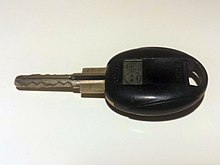Locking system
A locking system is a locking system consisting of several locking cylinders , whereby the individual locking cylinders are functionally related to one another.
Basic types
Locking systems are divided into the following basic types:
Keyed alike systems
Keyed alike or keyed alike means that several identical locks can be closed with just one key. For example, all the locks on most cars are keyed alike. This means that you can unlock or lock all doors, the ignition lock, the fuel filler cap and the trunk with just one key. Different locks such as padlocks, door locks and cabinet locks can also be manufactured with the same key (see standard lock ). In the narrower sense, a keyed alike does not count as a locking system.
Central lock systems
Central lock systems (Z systems for short) consist of one or more central locks that can be closed by all the keys in the system. In addition to the central locks, there are individual locks that can only be locked with the associated key and not with the other keys in the system. Whether a key can close a specific lock or several locks depends on its intrinsic values . Typical central locking systems can be found in apartment buildings. There the main entrance and, for example, the basement entrance are designed as central cylinders. All keys in the system can operate these cylinders. The apartment doors are individual locks.
Master key systems
Master key systems (HS systems for short) are hierarchically structured systems. There are one or more higher-level keys, the master keys, which lock in all cylinders of the system. The individual keys, on the other hand, can only close those lock cylinders for which they were made. Master key systems are used in schools, for example. For example, the keys to the classrooms cannot close the main entrance, while the higher-level keys can be used on all doors in the system.
Central master key systems
Central master key systems (Z / HS systems for short), also combined master key central lock systems (KHZ), are locking systems that combine the properties of central lock systems and master key systems. All individual keys have a central lock, but there is also a master key that closes all lock cylinders. An application example is a hotel in which the guest key locks the respective room and the front door, the room service has a master key that locks all lock cylinders.
General master key systems
General master key systems (GHS systems for short) are extended master key systems with additional hierarchical levels. There are individual locks that are grouped together. Keys are assigned to these groups. A group key closes several individual locks. Several groups are combined into main groups. Main group keys close individual locks from several groups. The general master key, often for short, the general key , closes all cylinders in the system. If there is a large locking system with a large number of hierarchical levels, the keys of the 2nd hierarchical level are sometimes referred to as the master key, and the upper group keys and subgroup keys are also used for the levels below. As the hierarchy descends, the number of different keys usually increases. General master key systems are used in large office buildings or in universities.
Labelling
For a locking system is usually a locking plan created that determines the allocation of the keys to the locks and the design of the locks. Every locking system has a unique, registered number, which is often important for the fire brigade in the event of a fire . The number is stamped into the handle (bow) of the key and also attached to the cylinders of the system. The identification can consist of letters, numbers or a combination of both. It can Apartment o, door numbers. Ä. Be integrated. The exact function of the key can be seen from the numbering on the locking plan, i. H. which doors can be locked with it. If the number is attached to the front of the key, it can even be read when it is inserted, which is often the case in larger buildings (airports, hospitals, etc.).
As a rule, a security card is issued for each locking system as proof of ownership. No duplicate keys can be obtained without this security card.
Types and properties
A distinction is made between mechanical and mechatronic locking cylinders within locking systems. Nowadays, purely mechanical locking systems are mostly manufactured with cylinder locks . In the case of mechanical locking cylinders, a distinction is made between conventional systems and reversible key systems. When using conventional locking technology, so-called serrated keys, hierarchical levels are achieved by separating the locking pins in the cylinder. In the case of keys with dimples, either the pins are also divided several times, or the higher-level keys contain more or fewer dimples, some of which are not queried in the subordinate cylinders. For a detailed description, see master key .
A modern variant is locking systems with an additional electronic transponder system integrated in the key head (key end piece that is touched with the fingers, also called key head) , which exchanges data with the electronic cylinder, which in turn performs the final release via an electrically operated coupling .
literature
- Carsten Biehlig: Building technology for administrators, landlords and brokers . Haufe-Lexware, 2005, ISBN 9783448055436 , pp. 243-248.
- Merschbacher A. (2018) Cylinders and locking systems. In: Safety Primer. Springer Vieweg, Wiesbaden, ISBN 978-3-658-21140-0





